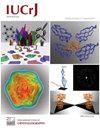大麻酚共晶的表面分析:连接晶体结构与增强性能。
IF 3.6
2区 材料科学
Q2 CHEMISTRY, MULTIDISCIPLINARY
引用次数: 0
摘要
大麻萜醇是从大麻中提取的一种生物活性化合物。它具有许多有前景的医药和营养保健特性。由于其固体形态热不稳定,溶解度低,且具有针状习性,不易配制成片剂或胶囊,因此使其使用和研究变得复杂。为了克服这些问题,我们进行了结晶筛选,目的是发现性能更强的新晶形。虽然多晶型和溶解物筛选没有发现新的形式,但共晶体筛选取得了成功。发现了两种共晶体,一种是哌嗪共晶体,另一种是四甲基吡嗪共晶体,两者的比例均为 1:1。后者可以以三种多态形式存在。这两种晶体的熔点和晶体习性都有所改善,含有四甲基吡嗪的共晶体还显著提高了溶解速率。我们采用了多种方法对新的固体形态进行了分析,包括 X 射线粉末衍射、核磁共振光谱、差示扫描量热仪、热重分析和内在溶解速率。利用单晶 X 射线衍射数据求解了晶体结构,然后与纯 CBG 的晶体结构进行了比较。利用 CSD-Particle 套件对晶体形态和表面进行了全面分析,并将各种特性与溶解速率联系起来。虽然表面附着能和粗糙度(崎岖度)没有显示出明显的影响,但未满足氢键供体的浓度显示出正相关性。有两个参数与溶解速率有很强的相关性:与水分子相互作用的倾向(由水探针计算的表面完整相互作用图的最大范围决定),以及正负静电荷的差异。事实证明,这些参数对水溶性溶解具有很强的预测性,在药物开发中具有巨大的实用价值。本文章由计算机程序翻译,如有差异,请以英文原文为准。
Surface analysis of cannabigerol cocrystals: linking crystal structure to enhanced properties
This study investigates the solid forms of cannabigerol and identifies two new cocrystals, showing significant improvements in physicochemical properties. The findings highlight the strong predictive capability of surface interaction parameters for aqueous dissolution, offering valuable insights for pharmaceutical development.
Cannabigerol is a bioactive compound derived from Cannabis sativa. It displays many promising pharmaceutical and nutraceutical properties. Its use and research are complicated by its thermally unstable solid form with low solubility and needle habit, preventing easy formulation into tablets or capsules. To overcome these problems, we conducted a crystallization screening with the aim to discover new crystal forms with enhanced properties. Though polymorph and solvate screenings did not yield new forms, the cocrystal screening was successful. Two cocrystals were discovered, one with piperazine and another with tetramethylpirazine, both in a 1:1 ratio. The latter can exist in three polymorphic forms. Both offer improvements in the melting point and crystal habit, and the cocrystal with tetramethylpirazine also shows a significant enhancement in dissolution rate. The new solid forms were analysed by a combination of methods, including X-ray powder diffraction, nuclear magnetic resonance spectroscopy, differential scanning calorimetry, thermogravimetric analysis and intrinsic dissolution rate. Single-crystal X-ray diffraction data were used to solve the crystal structures, which were then compared with that of pure CBG. The crystal morphologies and surfaces were comprehensively analysed using the CSD-Particle suite, with various properties correlated against dissolution rates. While surface attachment energy and roughness (rugosity) did not show significant effects, the concentration of unsatisfied hydrogen-bond donors displayed a positive correlation. There were two parameters with a very strong correlation to dissolution rate: the propensity for interactions with water molecules, determined by the maximum range in the full interaction maps on the surface calculated for the water probe, and also the difference in the positive and negative electrostatic charges. These parameters proved highly predictive of aqueous dissolution, offering immense utility in pharmaceutical development.
求助全文
通过发布文献求助,成功后即可免费获取论文全文。
去求助
来源期刊

IUCrJ
CHEMISTRY, MULTIDISCIPLINARYCRYSTALLOGRAPH-CRYSTALLOGRAPHY
CiteScore
7.50
自引率
5.10%
发文量
95
审稿时长
10 weeks
期刊介绍:
IUCrJ is a new fully open-access peer-reviewed journal from the International Union of Crystallography (IUCr).
The journal will publish high-profile articles on all aspects of the sciences and technologies supported by the IUCr via its commissions, including emerging fields where structural results underpin the science reported in the article. Our aim is to make IUCrJ the natural home for high-quality structural science results. Chemists, biologists, physicists and material scientists will be actively encouraged to report their structural studies in IUCrJ.
 求助内容:
求助内容: 应助结果提醒方式:
应助结果提醒方式:


